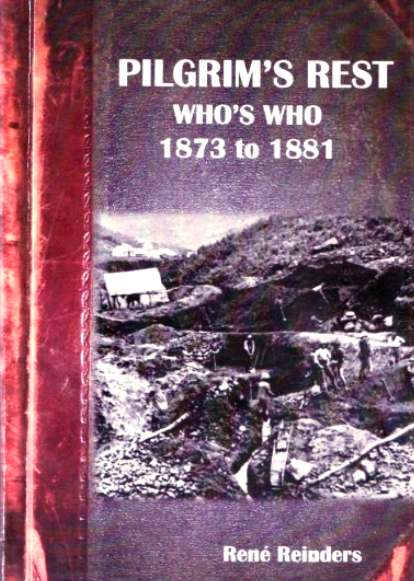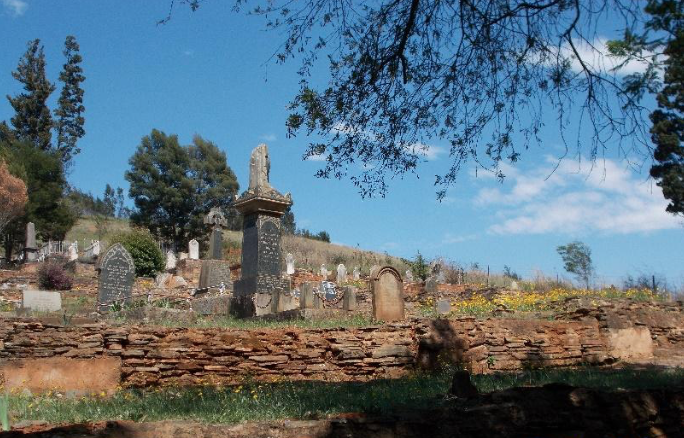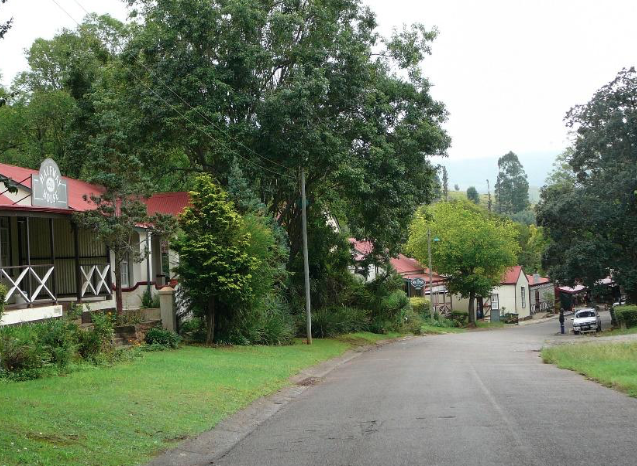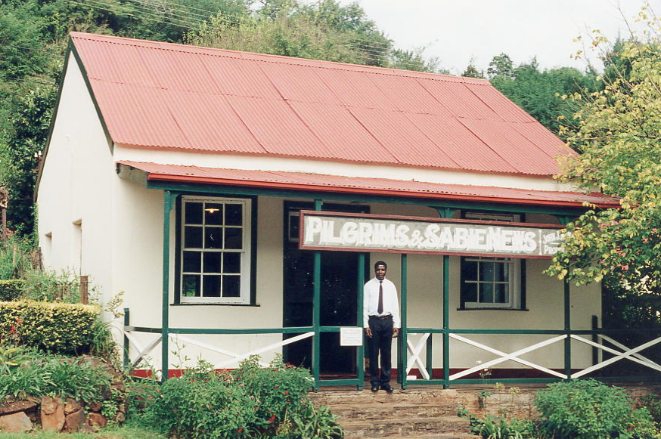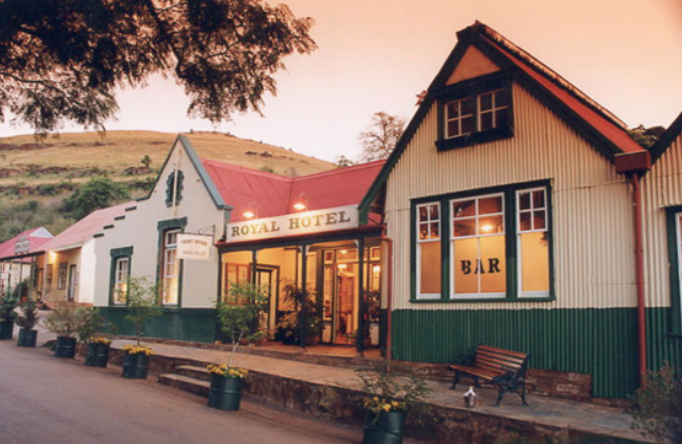
If you have ever visited Pilgrim’s Rest it is one of those places that stays with you and haunts your memory. It compares to Bendigo in Australia and Julian in California. It is still a tourist attraction of note in Mpumalanga and a village of romance and imagination. It is described in the online tourist blurb as a “a small town with a very colourful and exciting history”. The main street of this early mining settlement lives on its heritage and here you expect to find at least six bars to quench the thirst of the gold panner. I can remember once staying in the Royal Hotel, which was (and still is) an old fashioned place, where the smooth cement floors were that uniquely South African highly polished red ochre. It is a town whose gold mining past precedes that of Johannesburg and it is here that so many of the mining hopefuls raced to seek gold and make their fortune in the 1870s. Pilgrim’s Rest placed the Transvaal goldfields on the map.
Pilgrim’s Rest was a gold mining camp way back in the 1870s and was founded because of the discovery of alluvial gold in the valley. The pilgrims who came to rest here were the gold prospectors and their spirit echoed off the hillsides. They came to this valley when the Pilgrim’s Rest / MacMac and Spitzkop areas were officially declared a gold field in September 1873. Within months of the declaration, experienced gold diggers from California (those old 49ers) and Australia (there were gold rushes in Victoria and New South Wales in the 1850s) arrived to stake their claim and find their nugget. The first to arrive were the fortune hunters and the prospectors. For these old timers the search was probably more important than the making of a legacy fortune. The next wave were unskilled labourers and those who came to offer their services to the gold digging community - the shopkeepers, the canteen owners, the publicans, the lawyers, the transport riders and the bankers. Then came the women and children who really made the community. By September 1874, 4 282 claim licenses had been issued. Gold fever infected thousands drawn to the creeks, rivers and valleys of the Lowveld. The 1870s was the heyday of Pilgrim’s Rest and this book captures the mood of the time.
Book Cover
By 1881 it was all over and when the Transvaal regained its independence after the First Anglo-Boer War, the South African Republic granted a concession to a certain David Benjamin who was given the sole rights to all the minerals on the Pilgrim’s Rest Goldfields. Benjamin formed the Transvaal Gold Exploration and Land Company in 1881 and the era of the fiercely independent digger came to an end. The prospectors moved off to other Transvaal gold prospecting possibilities - Barberton and then the Witwatersrand. But on the Witwatersrand, gold was not alluvial and miners needed deep pockets, capital equipment and access to cheap unskilled labour to mine the underground banket in the reefs. Pilgrim’s Rest was a tough mining camp and very different from the Witwatersrand. What made it unique and hence endlessly fascinating was that it became a village almost frozen in time, a tourist mecca but secondly so many extraordinary characters were drawn to this early gold field.
The historic cemetery of Pilgrim’s Rest (René Reinders)
René Reinders is a woman with a passion who lives in Pilgrim’s Rest. She is driven by the history of the town and its people. For more than twenty years she has compiled a database of the prospectors and miners of the area. She is the Vice-Chair of the South African Gold Panners’ Association. She is a local amateur historian who has now published her life’s work in the 3rd edition of Pilgrim’s Rest Who's Who covering a mere 8 years of the town's history, but perhaps the most important years, 1873 to 1888. (I wondered when the 1st and 2nd editions were published as I had not come across an earlier edition - but this third edition is definitely the one to acquire.)
This is a self-published book and is the weightiest of efforts. It comprises the biographies of 1411 characters who came to Pilgrim’s Rest. René has ferreted out, researched and documented the life stories of anyone who had anything to do with Pilgrim’s Rest in that crucial decade. It is a remarkable labour of love. She is a local history buff who loves the smallest of detail and believes in amassing information from sources authoritative and inconsequential. She became fascinated with her subject (almost obsessed) and dug out almost every possible grain of information about the town, its people and its early mining camp history.
The Main Street of Pilgrim’s Rest (René Reinders)
If you want to know about the folks of Pilgrim’s Rest - the hopefuls, the failures and the successes then this is an excellent book to dip into. I am interested in that process of town and community formation and how race and class shaped a mining camp. It could have grown into a Johannesburg, but the gold ran out. But in its day several million pounds sterling (in the era of the Gold Standard) was found and sold along the middlemen channels to reach London and augment the British sinews of empire. The period covered in this book is a narrow one but the vein of gold the author seeks to mine is deep. It is fascinating to realize how quickly law and order was established and a community of great diversity and substance took shape. A gaol was as important as a bank or a bar.
René also knows a great deal about Pilgrim’s Rest history over a longer time period and has captured that information in an introductory essay that sets the scene explaining the context for the Pilgrim’s Rest gold fields but also the many other locations of gold finds: MacMac, Spitzkop, Rosshill, Waterfall Creek, Kameel’s Creek, Robus’ Rush and Rotunda Creek Rush. The final chapter, in brief outline, is about what happened to Pilgrim’s rest post 1881, after the day of the solitary mining characters had passed and where the Transvaal Gold Exploration and Land Company consolidated what was now a heavily worked out gold field. The day of the romantic old time iconic prospector was over.
The Printing Museum of Pilgrim’s Rest (René Reinders)
This Who’s Who is a reference book, arranged alphabetically. It is a rich gold mine of information gathered and presented somewhat indiscriminately but nonetheless this takes nothing away from its value as a new historical source. There is no balance in the length of an entry. Some entries for significant people such as Sir Arthur Cunynghame, Ignatius Ferreira, Frank Rhodes, Walter MacDonald or Hans Sauer are lengthy simply because there is a lot of information but in the case of others such as William Farren (market master), J Feilen (digger) or Christopher Fell (another digger) there is just a sentence. René has listed her source of information for each entry and this is most commendable and professional. She has then included a useful bibliography but the book lacks an index. Her use of the primary sources drawn from the Pilgrim’s Rest museum archive, such as the register of burials and the Transvaal Gold Mining Exploration Company’s letter books shows many hours of committed labour. Her use of the national archival sources such as the State Secretary documents is equally impressive. How she accessed and used these primary documents should be explained and could be a useful guide to other researchers.
René has also made considerable use of internet sources; but there is a danger and risk as an internet source (assuming it is not a digitised copy of an original source) is only as good as the original source material on which writing is based and it is far better to get back into the original documents wherever possible, for example, the old newspaper entries.
There were a few surprises and shortcomings. The first essential of any biographical dictionary is to give the date of birth and the date of death or to state that such essentials are not known. Then surely the Dictionary of South African Biography produced under the auspices of the Human Sciences Research Council should have been used. I wondered if René did not know of this invaluable resource. I picked up more than a dozen entries where the biography recorded in the DSAB is far better, fuller and more insightful than in this Pilgrim’s Rest compilation.
I shall analyse one entry – that of Francis Oats (b 1848 Cornwall, d 1918 Port Elizabeth). The DSAB entry was written by W D Maxwell-Mahon and is a rounded essay on Oats who was a mining engineer, prospector and diamond industry leader. Maxwell-Mahon draws on the 1905 South African Who’s Who, two obituaries written in 1918, Chilvers on De Beers and Alpheus Williams amongst others. In contrast the Reinders entry is culled from R Dawe: Cornish Pioneers (published in 1998), plus three internet sources. Why not use the most authoritative biographical entry available?
On the other hand the DSAB has no entry on Herbert Rhodes, the far less significant brother of the younger Cecil, but Reinders has an excellent entry on him sourced from at least five contemporary sources in addition to the secondary sources. Stafford Parker was an important historical figure who achieved notoriety as the President of the short lived Diggers Republic in Kimberley in 1870. If you really want to learn something of Stafford Parker, rather turn to the DSAB, Vol 5, p 566. The large body of literature on the Struben Brothers has also been missed.
Nonetheless, Reinders is to be congratulated on her efforts to source and include women in her biographical dictionary, bringing the wives, daughters, independent female adventurers and hotel keepers out of the shadows of male dominance. For example, there was Mary Gracie who owned a hotel in Pilgrim’s Rest between 1874 and 1877 or Selena Byerley (nee Ford) who moved to Pilgrim’s Rest with her husband George and had eleven children, two of whom died and were buried in Pilgrim’s Rest. They then went to Barberton and after her husband’s death in 1893, she ran a boarding house and following a second marriage to William Bales, moved to Mozambique.
Then there was Mary Button who lived to be 100 and only died in 1950; she was married to gold prospector, Edward Button and followed her husband to Eersteling and then Pilgrim’s Rest. Or there was Anne MacLachlan who was awarded the Burgers Cross by President Burgers for her nursing services to the transport riders and diggers community during the frequent outbreaks of malaria.
A strength of Reinder’s efforts is to give acknowledgement and flesh out the lives of the ordinary man and woman, who had dreams and ambitions and were the people who populated and built the mining communities, and so contributed to the fabric of South African history.
Reinders has also made a huge effort to document the stories of black, coloured, Indian and Chinese people on the Pilgrim’s Rest gold fields. She has tried to indicate ethnic origin and again a round of applause is deserved for giving recognition to all the different cultures and groups who found their way to the Transvaal Goldfields in the 1870s. Where she does not know an initial she gives the title, “Mr”, so there was a Mr Jim who was a black man in the employ of the postmaster, who was a heroic character and saved the lives of several diggers at death’s door from malaria. Or there was a Mr Madungu or a Miss Mahlabane who were children killed in an attack on Buffel’s Kraal at MacMac in 1876, but we are left in the dark as to who were the attackers. There sometimes was justice for black men, for example a certain William Harper assaulted a Shangaan, a Mačea Madonga in 1874; Madonga was seriously injured and Harper was banished from the goldfields.
This book adds to the fairly substantial literature on Pilgrim’s Rest. A P Cartwright with his Valley of Gold (1961) first published a readable history of Pilgrim’s Rest. A source missed by Reinders was the excellent University of Pretoria Argitektuurblad for 1969 on Pelgrimsrus. In 1973, R W Kitto and A P Cartwright collaborated on a portfolio of 6 original paintings (Kitto) and a booklet length essay (Cartwright) - Pilgrim’s Rest The First Hundred Years 1873-1973. This was published in a limited number edition and is now a much sought after collector’s item. Then there was the Transvaal Provincial Administration Library and Museum Service publication, Annals of the Museum Service, Number 1, Pilgrim’s Rest, A Pictorial History (1986), a dual language publication of photos with over 50 old photographs. I suppose I have been interested in Pilgrim’s rest since my parents took our family on a holiday to the “Eastern Transvaal“ (now Mpumalanga). As I said, Pilgrim’s Rest is a place to remember and hence as an adult I found myself always buying Pilgrim’s Rest ephemera.
The many characters who came to Pilgrim’s Rest in its prime, spring from these brief thumb nail sketches. I love the richness of the detail and the grasping at the smallest snippet of information. There were so many characters of note - robbers, murderers, policemen, prospectors, diggers, bar keepers, wives, and mothers.
This book is a labour of love and a lifetime’s passion. For the 4th Edition, a professional publisher’s guidance will help to get rid of the small errors in script and improve the lay out. It is commendable to have maps but these need to be readable to add value. Perhaps a future project for René is to write the authoritative history of Pilgrim’s Rest? This dictionary is useful as it becomes a source for other historians who draw conclusions about longevity, economic trends or migratory patterns.
I am interested in the later history of Pilgrim’s Rest. In 1895, the Transvaal Gold Exploration and Land Company amalgamated with other companies and the Transvaal Gold Mining Estates Company emerged. Here one can consult A.R.C. Fowler of Rand Mines who published an article on this company in the Journal of the Southern African Institute of Mining and Metallurgy, Volume 68, Issue 7, Feb 1968, p. 291 – 335. Hence it would appear that the TGME Company became part of the Rand Mines stable, and in later years there were issues around land claims and who actually owned what. In 1972 the TGME closed down the Beta mine, the last operational mine at Pilgrim’s Rest. In 1974 the Provincial Administration took over the management of Pilgrim’s Rest as a living museum. But that subject and era is another one entirely.
Reinders informs us that after more than a century of mining an estimated 155 metric tons of gold (five million ounces or 155,517 kilograms) plus a considerable amount of silver was recovered from the Pilgrim’s Rest Goldfields. An impressive achievement.
During the 1870s, pilgrims and alluvial gold diggers came to the valley of Pilgrim’s Rest. A Reverend Gerald Herring summed up the typical character. To him they were hard working men of strong personality, fierce passions, generous dispositions and great vitality. These were men who were often known by nicknames and aliases. They were men for whom the thrill of the hunt for gold was more important than finding or keeping it. Many found gold but lost it in drinking and gambling. Many left Pilgrim’s rest as poor as when they arrived. These were the pioneers, the fortune hunters and the prospectors of the era. René’s book pays homage to these men and women of all classes, races and castes.
2019 Guide Price: R250
(Available from René Reinders - Rene.Reinders61@gmail.com. Add the price of a courier delivery. Also available from the Pilgrim’s Rest Information Centre.)
Kathy Munro is an Honorary Associate Professor in the School of Architecture and Planning at the University of the Witwatersrand. She enjoyed a long career as an academic and in management at Wits University. She trained as an economic historian. She is an enthusiastic book person and has built her own somewhat eclectic book collection over 40 years. Her interests cover Africana, Johannesburg history, history, art history, travel, business and banking histories. She researches and writes on historical architecture and heritage matters. She is a member of the Board of the Johannesburg Heritage Foundation and is a docent at the Wits Arts Museum. She is currently working on a couple of projects on Johannesburg architects and is researching South African architects, war cemeteries and memorials. Kathy is a member of the online book community the Library thing and recommends this cataloging website and worldwide network as a book lover's haven.

